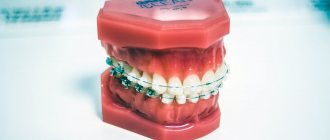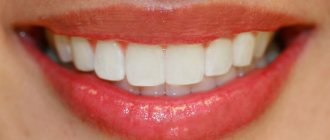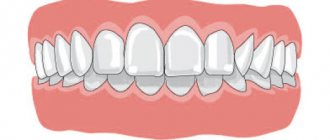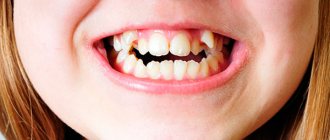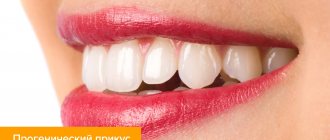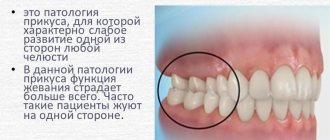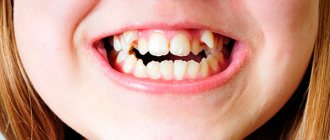The bite is the relationship between the teeth of the upper and lower jaws when they are closed. Depending on the nature of the closure, the types of bite are distinguished. It can be right and wrong. Doctors also talk about physiological and pathological occlusion. For example, if the jaw is too forward, so that individual teeth protrude and stick out, then correction is necessary.
An orthodontist deals with bite problems in children and adults. You can determine a malocclusion yourself. In front of the mirror, you can notice that the closure of the teeth is not ideal. In addition to aesthetic defects, malocclusion is also fraught with disturbances in facial expressions and speech. Facial asymmetry is often observed, which causes psychological problems to arise.
What is correct (physiological) bite
Physiological types of occlusion are characterized by the correct closure (occlusion) of the teeth. There should be no gaps, gaps or bony protrusions between the teeth. Correct occlusion is established only when all teeth are located along the center line.
Correct types of occlusion do not involve disturbances in chewing function. The upper jaw is shaped like a semi-oval, and the lower jaw resembles a parabola.
A physiological bite gives a person the following advantages:
- aesthetic smile;
- correct articulation and clear speech;
- correct primary processing of food (chewing).
Types of anomalies
There can be several types of malocclusions. Let's take a closer look at them.
Deep bite
In dentistry, deep bite is considered the most common defect . Its main feature is the following: when the jaws close to each other, the upper row of teeth overlaps the lower one by a third.
In this case, there is a large load on the front teeth , and due to their contact with the oral mucosa, injury can occur. With such a defect, a violation of the aesthetics of the face occurs, that is, the lower part visually becomes shorter, the lips acquire an unattractive position.
Treatment of deep bites should begin as early as possible , since this pathology leads to loosening and loss of teeth. Ideally, treatment should begin at an early age. For this purpose, plates and braces are used, thanks to which the teeth are aligned, and thus this problem is corrected.
Open bite
An open bite is a type of anomaly in which there is a small gap between the rows of teeth. At the same time , a person with such a defect always has his mouth slightly open. As a result, he feels discomfort, since due to this problem there is always a dry mouth, the functions of digestion, speech, and breathing are disrupted.
The reasons for this anomaly can be poor heredity, jaw deformation, and bad habits at an early age , for example, thumb sucking, nail biting, as well as infectious diseases suffered by the mother during pregnancy.
Open treatment is special for each age. During the period of early treatment, myogymnastics has proven itself very well in children. In order to wean a child from bad habits, special plates with a tongue rest are used.
If treatment occurs at an older age, then various mouth guards are recommended to correct the problem. Typically, better results are achieved if treatment is started early.
Crossbite
In dentistry, there is such a type of malocclusion as crossbite. It is considered a severe disorder and can occur in both adults and children.
A distinctive feature of this pathology is the crossing of the dentition during the period when the jaws close.
There are more than enough reasons for the development of crossbite . This is both heredity and improper formation of teeth in childhood. This can also be caused by the fact that a person often develops caries.
The following forms of crossbite are distinguished:
- Buccal - represents a narrowing of the upper teeth and widening of the lower ones. This form can be either one-sided or two-sided.
- Lingual - it can also be unilateral or bilateral. Its peculiarity lies in the fact that there is an expansion of the upper dentition and a narrowing of the lower one.
- Buccal-lingual is a combination of the first and second forms.
The most unpleasant thing with such a defect is that the aesthetics of the face is impaired, and the chewing function is also impaired, which leads to problems with the gastrointestinal tract.
If such an anomaly is detected at an early age, then doctors suggest performing myogymnastics and grinding the incisors. If crossbite is detected late, patients are offered treatment using various medical devices.
Distal bite
One of the anomalies of malocclusion of teeth is distal. In this case, when the dentitions close, the upper one moves forward slightly in relation to the lower one.
The reasons for the formation of a distal appearance are varied. This can be a sore throat, breathing problems, various bad habits, and genetic predisposition can also lead to this.
This type of behavior entails disastrous consequences. Chewing and swallowing functions are impaired. There is a very high risk that caries, periodontal disease, and periodontitis may develop.
Treatment of this anomaly in children occurs with the help of dental guards and trainers, which help the development of the lower jaw, and at the same time prevent the development of the upper jaw . In adults, braces are used.
Mesial bite
A mesial bite in humans is when the lower jaw is very forward. A distinctive feature of this pathology is a forward chin , the lower teeth are located above the upper ones, which creates a concave facial profile.
There are different reasons that can cause this type of anomaly:
- trauma received by the child at birth;
- bad heredity;
- early loss of upper milk teeth;
- rickets.
Correcting this problem is a very long process , and therefore the sooner it starts, the more effective the treatment will be.
In children , when using mouth guards to correct this problem, treatment will be quick and successful . In an adult, the process lasts longer and can be carried out using braces, as well as through plastic surgery.
Reducing (acquired) bite
In dentistry, there is such a thing as a reducing, or more simply put, acquired bite. It develops during the period of permanent occlusion due to pathological abrasion of teeth, with defects in the dentition.
Such people experience pain when chewing food, facial pain, there is also decreased hearing, headaches, and when the head is tilted down, there is a rush of blood to the face.
Treatment of patients at the initial stage of this disease does not require much time and expense, the main thing is to prevent the progression of pathological tooth abrasion. Treatment is preventative. For preliminary treatment of this anomaly, it is recommended to use a standard joint splint.
Correct bite: how to understand
To evaluate your bite, you need to see a dentist. The doctor will do this quickly and accurately. If you want to do this yourself, you should know that a correct bite satisfies the following requirements:
- When the upper jaw contacts the lower jaw, an ideal contact is formed between the opposing teeth (upper and lower).
- The central front teeth (incisors) are positioned symmetrically. That is, they are equidistant from an imaginary line running down the center of the face.
- The dentition should be smooth, without gaps or crevices.
- It is considered normal if, when closed, the upper teeth cover the lower teeth by about a third.
Important! The criteria described above, which can be used to determine the bite, are for informational purposes only. Only a doctor determines the types of bite and makes a diagnosis.
Shape of teeth during prosthetics
Thanks to prosthetic techniques, you can make your teeth straight and restore chewing functions. This process is quite complex, the methods may differ slightly, and specialists use different materials. Before prosthetics, it is important to choose the shape of the dental units. Patients often think only about the aesthetic issue of prostheses, while it is worth taking into account the physiological aspects. Dentures that are incorrectly shaped create an incorrect bite, and they are also completely uncomfortable to wear. Not every patient knows that malocclusion, which occurs due to improperly selected dentures, often causes problems: snoring, headaches and migraines, and hormonal imbalance. The teeth should close evenly over the entire chewing surface.
When creating a prosthesis, the most important thing is to make a design that will exactly replicate the natural bite. It is also necessary to determine the location of the facial muscles as accurately as possible - this is necessary to make a model suitable for the patient. To achieve an ideal smile and create the correct shape of the lower teeth, you need to contact an experienced orthodontist. Chewing teeth of the correct shape are the basis of a correct bite. Full fit of the jaws will restore chewing function.
Correct bite: types
There is no ideal physiological bite. There are only types of occlusion that are close to perfect and do not require orthodontic or surgical intervention. Let's consider the main physiological types of occlusion.
Orthognathic occlusion
Orthognathic is considered the most correct bite, and is found in 90% of people with physiological occlusion. Orthognathic bite can be determined at home. Permanent teeth should fit tightly together. In this case, the upper incisors slightly cover the lower ones.
Straight bite
In a straight bite, the upper and lower jaws are the same size. At the same time, both the incisors and chewing teeth close. Individuals with a straight bite can boast a very beautiful smile.
However, such a closure is not without its drawbacks. Direct bite is dangerous due to premature destruction of hard dental tissues. This is due to the increased load on the teeth when closing. In this case, the enamel wears off faster, cracks and chips form.
Biprognathic bite
Biprognathic types of occlusion occur in children and adolescents who have the habit of thumb sucking. Also, these types of closure can develop in a baby if it is too late to wean him off the pacifier.
With this type of bite, the incisors bend slightly forward. At the same time, they come into contact, and for this reason such a bite is considered physiological.
Progenic bite
This is a normal option provided that the teeth develop normally. A feature of a progenic bite is that the lower front teeth are slightly pushed forward.
Varieties and characteristics
When talking about what types of dental occlusion there are in adults in dentistry, there are two basic categories. In the first case, we are talking about correct occlusion, characterized by a harmonious relationship, natural facial contours, proportional shapes and symmetry of the midline and the junction of the frontal incisors. Such an anatomical structure not only ensures the aesthetics of a smile, but also allows you to fully realize the main tasks of the jaw region, which include food processing, as well as respiratory and speech functions. In turn, incorrect development is accompanied by more or less pronounced anomalies, often causing both physical and psychological discomfort to patients.
Physiological types of occlusion
Not only defective, but also natural conditions are subject to orthodontic classification. The ratio is divided into three varieties, the membership of which is determined by the indications of visual and hardware diagnostics.
Orthognathic
It is considered a reference because it provides optimal conditions necessary for the implementation of functional tasks. It is characterized by the overlap of the lower row with the upper by about a third of the height of the incisors, close contact when closing, as well as the absence of spaces and interdental gaps.
Biprognathic
A bite, the distinctive feature of which is the presence of a slight vestibular inclination, with a vector oriented towards the vestibule of the oral cavity. In this case, the frontal units retain points of contact, and the canines of the maxillary region are covered with antagonists for several millimeters.
Straight
It is diagnosed in cases when the cutting edges of the anterior incisors, which form the visible area of the smile, contact each other when closing, while the occlusion of the chewing molars remains correct. Eliminates the presence of empty areas, trema and diastemas, as well as signs of crowding.
The meaning of correct bite
The human body is a complex biological system in which each element affects the overall condition. Correct occlusal closure not only ensures the implementation of basic functionality, but also eliminates side effects such as joint pathologies, diseases of the gastrointestinal tract, as well as heart and blood vessels. The asymmetrical position of the jaws leads to incorrect redistribution of the load, which ultimately forces the muscles to readjust, causing a change in posture, causing pain and dizziness.
When is the tooth relationship considered incorrect?
Factors indicating abnormal development include:
- Lack of contact between antagonists.
- Diction defects.
- Problems with chewing food.
- Distortion of facial features.
- Deformation of the jaws.
- The occurrence of pain syndrome.
The presence of even one of these signs is considered sufficient grounds for diagnosis. Practice shows that the earlier deviations are detected, the easier it is for the patient to eliminate them. Dental specialists use modern methods and technologies to determine the specifics of existing bite defects and draw up an optimal treatment plan that takes into account individual indications and recommendations.
Malocclusion: causes
Malocclusions are formed for a number of reasons, including:
- Hereditary factors . One of the leading causes of abnormal bite is genetics. The size and shape of the jaw are determined by genes received from the mother and father. Pathologies such as too narrow a jaw, cleft bite, misaligned dentition and other disorders are often dictated by hereditary factors.
- Nutrition . Malocclusion is considered one of the problems of modern civilization. In particular, we are talking about a situation where the lower jaw is underdeveloped. This is due to the abundance of liquid nutrition in childhood, which is why the lower jaw does not work fully.
- Mother's illnesses during pregnancy . Some abnormal types of bite occur due to maternal illness, especially in the first trimester of pregnancy.
- Wrong selection of pacifiers . An incorrect bite can develop if the nipples are not selected correctly. It is important that the baby makes an effort to obtain milk. Otherwise, underdevelopment of the lower jaw occurs.
- Bad habits in childhood . For example, thumb sucking and excessive use of pacifiers. Sleeping position also affects your bite. Often a malocclusion is formed when the head is thrown back.
- Diseases of the ENT organs . It is important to treat ear, nose and throat pathologies in a timely manner. With such diseases, the child is often forced to breathe through the mouth. Therefore, diseases such as sinusitis, rhinitis, adenoids and deformation of the nasal septum require adequate and competent treatment.
- Physical development disorder . In particular, we are talking about diseases affecting the growth and development of bones.
Bite formation in children
At the stage of bite formation in children, there are three most important periods:
- The milk bite begins to form at six months of age and continues until 3 years of age. This is the initial stage during which the foundation for the formation of a permanent bite is laid.
- The change to a permanent dentition lasts up to 9 years. During this period, the jaws actively develop and a permanent bite begins to form. During this period, when the dentition consists of baby and permanent teeth, children often develop malocclusions. Common causes are a violation of the pairing of teeth erupting with an unequal degree of development of the jaw sections.
- The formation of a permanent bite occurs from 12 to 15 years. The replacement of baby teeth ends, permanent teeth complete their growth and are installed in their permanent places.
Prevention of malocclusion in childhood is very important, as it determines whether the child will have problems in the future. Adults should monitor the eruption of permanent teeth in children and visit an orthodontist with the child for timely detection of anomalies and bite correction.
How to determine a pathological bite
Pathological types of bite are determined by the doctor. If you suspect a problem in yourself or your child, you should contact the dentist. Here are some features of pathological bites that you need to pay attention to:
- The teeth do not close tightly. Gaps and gaps form between the upper and lower teeth.
- There is partial or complete lack of contact between opposing teeth (incisors and/or chewing molars) (there is a short gap in the horizontal plane).
- The upper jaw is noticeably smaller than the lower jaw or vice versa.
- Dental crowding or occlusion, where teeth overlap each other.
- The presence of a diastema - a noticeable gap between the incisors.
- Change in appearance. For example, the lower jaw is shortened and the lips are turned inward.
- Exposure of tooth roots and other defects of hard dental tissues. For example, an indirect sign of malocclusion is poor enamel and wear of the cutting edges.
Reasons for formation
The causes of malocclusion in both adults and children can be different. Let's take a closer look at them.
Causes of malocclusion in children
- One of the reasons for malocclusion in children is heredity. And for this, it is very important that parents and their child visit an orthodontist when the child is 2-4 years old.
This is the most favorable time to take preventive action if violations are identified. - The second reason can be called the moment if the child does not eat mother’s breast milk , but receives it from a bottle, and the nipple has a large hole.
At this time, the child’s lower jaw practically does not work, as a result of which it develops less. This also includes the position of the baby’s head during feeding; the same position should not be allowed. - The third reason may be bad habits , such as a pacifier that the child sucks for a very long time, or thumb sucking. This can cause a gap to appear between your front teeth.
- The fourth reason can be considered diseases associated with the nose or throat. The child has to breathe through his mouth, which leads to unpleasant consequences.
Causes of malocclusion in adults
The main causes of this problem in adults are considered to be genetic. Also, the reasons include various kinds of chronic ENT diseases, which lead to disruption of normal nasal breathing; rickets suffered in childhood, caries, bad habits (biting the lower lip, tongue).
Malocclusion: types
Like physiological types of occlusion, pathological ones also come in different types. Below is a classification of malocclusions.
Distal bite
This is a type of malocclusion in which the upper jaw is highly developed compared to the lower jaw. For this reason, the upper teeth move noticeably forward.
Mesial bite
In this case, the lower jaw protrudes noticeably forward compared to the upper jaw. Sometimes there is a retraction of the upper lip. Often, with mesial occlusion, the functioning of the temporomandibular joint is impaired.
Crossbite
It is observed when the jaw shifts to the right or left. In this case, 1-2 teeth are in the wrong position.
Deep bite
In this case, the upper teeth cover the lower teeth by more than half. With a deep bite, a speech defect is observed, and the oral mucosa is also injured.
Open bite
There is a large gap between the dentition during occlusion. This is due to the fact that some teeth cannot close when closed. Open bites often occur when a child sucks a finger or a pacifier for a long time.
Types of prevention of malocclusions
Prevention of malocclusion in childhood is very important, as it determines whether the child will have problems in the future. Adults should monitor the eruption of permanent teeth in children and visit an orthodontist with the child for timely detection of anomalies and bite correction.
Prevention of malocclusions involves eliminating bad habits that cause one or another anomaly: lip biting, finger sucking in children. To do this, special plates are used that block the ability to use a bad habit. In adults, such methods help cure abnormalities in the early stages.
It is important to carry out sanitation of the oral cavity in a timely manner and periodically come for medical examinations to the dentist. Children from the age of six months should be taught to chew solid food.
A good method of prevention is specially designed therapeutic exercises. When performing exercises, the patient puts the correct load on the jaw muscles, which contributes to the harmonious development of the maxillofacial system.
Bite in the absence of teeth
If the patient has no teeth left, then there is no guarantee that prosthetics will be able to achieve an anatomically correct jaw. In this case, much depends on the initial positions (what the bite was like before losing teeth). If the upper and lower jaws are positioned relative to each other within normal limits, then the bite can be straightened with minor corrections. If the patient had problems with the jaw bones, then a deeper correction is required.
In the absence of teeth, the bite is determined using wax rollers. This creates an imitation of the dentition, which allows for standard changes. For this purpose, special plates and a curved, arc ruler are used. After all measurements and preparatory procedures have been carried out, a plaster and then a regular prosthesis is initially created in the dental laboratory.
Important: bite after wisdom tooth removal . Wisdom teeth were important for ancient people, but now there is no need for them. If wisdom teeth do not cause problems for a person, then doctors recommend not touching them. However, in cases where an adult wants to correct an incorrect bite, wisdom teeth can help with this. Thus, correction of the bite in adults is possible after the removal of wisdom teeth. The space formed after their removal allows the dentition to take an anatomically correct position.
How long does it take to correct a bite?
Each case is individual, so without visiting a doctor it is impossible to say how long treatment will take.
The minimum treatment takes a year for the bone to grow and the teeth not to come back. The result needs to be stabilized. Patients often tell me after two months of wearing braces: “I want to take them off, everything is already straight for me!” But this is appearance. The jaw bones must anchor the teeth into their new position.
The duration of treatment also depends on the patient. The orthodontist puts a certain force into the braces, which weakens by the next visit. That is why it is important to strictly visit the doctor once a month so that you do not have to prolong the course of treatment.
My teeth began to loosen. Something is going wrong?
Loose teeth after installation should not scare you. The teeth will be in motion throughout the treatment period. Essentially, we move our teeth: somewhere the bone dissolves, somewhere it appears. Six months after treatment, the teeth will return to normal.
The purpose of braces is to change the position of hard and soft tissues adjacent to the tooth. But this is not enough to correct the bite. Teeth may move back apart some time after braces are removed if a retention device is not in place. After correction, retainers must be installed to keep the teeth stable in their new position. If this is not done, the effect of wearing braces will gradually disappear.
Malocclusion: consequences
Malocclusion is a problem that should not be underestimated. Over time, malocclusion can lead to the following consequences:
- Premature tooth loss . This is due to two factors. Firstly, an incorrect bite increases the load on the teeth. This threatens the appearance of cracks and chips. In addition, an abnormal bite increases the risk of developing periodontal disease. This leads to accelerated tooth decay.
- Damage to the gums . With an incorrect bite, gum health deteriorates. They become sensitive to temperature, chemical and physical factors. In some cases, this leads to the formation of ulcers on the gums.
- Pathologies of the temporomandibular joints . The most common symptoms are a clicking sound when chewing, which should not normally be present. Then pain occurs, and the function of the joint deteriorates even more.
- Diseases of the digestive system . Well-chewed food is one of the conditions for normal functioning of the gastrointestinal tract. If the bite is broken, then relatively large pieces of food enter the stomach. Due to poor initial processing of food in the oral cavity, over time a person develops eating disorders.
- Psychological problems . Pathological types of bite often worsen a person’s appearance. This is how low self-esteem is formed. A person becomes overly modest, fearful and unsure of himself. Sometimes, in order to improve the situation, in addition to dental treatment, the help of a psychologist is also required.
The importance of routine observations in normal occlusion
In children with an orthognathic or straight bite, the arrangement of dental units in a row may change due to untimely (early or late) change of primary teeth. During a preventive examination, the orthodontist will identify the presence of abnormalities in the rudiment itself. The following types of preventive measures are carried out:
- Clinical examination (allows us to identify existing anomalies and risk factors).
- Formation of groups of patients for further clinical observation.
- Drawing up a plan of preventive and therapeutic measures (pediatricians of all profiles participate).
In adult patients with normal dentition, malocclusion can develop under the influence of external and internal unfavorable factors. The main reasons that increase the risk of developing dental anomalies in adults are:
- carious process;
- loss of teeth;
- various types of prosthetics;
- prosthetics errors;
- bad habits.
During the examination, the dentist will identify the presence of predisposing factors, after which he will develop a scheme for carrying out preventive measures to maintain a normal bite. Selection is carried out on an individual basis, taking into account the condition of the dental system and the physiological characteristics of the patient’s body.
Treatment of malocclusion
Today, malocclusions are treated using various techniques. Most often, the curvature can be corrected with orthodontic methods, but in some cases surgical correction is necessary. Let's look at the most effective ways.
Orthodontic plates
These are removable hard plates that allow you to maintain the correct alignment of your teeth. Such structures consist of a plastic base and metal elements that hold the plate in the oral cavity.
Orthodontic plates are often used in pediatric dentistry. These products help develop the habit of breathing through the nose and also stop thumb sucking. In this case, the correct bite is formed due to the work of the muscular system. Depending on the tasks assigned, different types of plates are used. These are standard plates, plates with a visor, a flap or a bead. The plates are made from hypoallergenic materials. Those with baby teeth usually have soft plates installed. For permanent teeth, hard ones can be used.
Trainers
Another way to even out an uneven bite is to use trainers. These orthodontic structures are a two-jaw mouthguard made of silicone or polyurethane. Changing the bite with trainers occurs due to muscle work.
It is noteworthy that the result of such treatment persists even after the end of the course, because muscle memory is preserved. Trainers are successfully used for the following problems:
- open and deep bite types;
- mouth breathing;
- speech defects;
- crowded teeth;
- bad childhood habits (for example, thumb sucking);
- incorrect position of the lower jaw.
Treatment with trainers is carried out in 2 stages:
- First stage . It lasts 6 months and involves wearing soft trainers. This is necessary in order to activate the work of the chewing and facial muscles.
- Second phase . Soft trainers need to be replaced with hard ones. Such trainers directly affect the position of the dentition.
Advantages of trainers:
- affordable price;
- absence of unpleasant sensations;
- the ability to remove the structure while eating or talking.
Aligners
These are dense transparent trays for straightening teeth. Aligners are made individually for each patient. As a rule, this is a series of designs, each of which is worn for a certain period of time, and then replaced by a new one. This is a kind of cascade correction method. The disadvantage of this treatment is the relatively high price.
Braces
One of the most effective orthodontic methods of bite correction is braces. These are special locks connected in an arc. For more successful treatment, braces are also equipped with special elastic bands (or pulls). With the help of elastic bands, it is possible to increase the pressure on the dentition that needs to be corrected.
Incorrect types of bite are treated with braces in several stages:
- Preparatory . At this stage, diagnostic measures and selection of a treatment regimen are carried out. Professional teeth cleaning, plaque and tartar removal are carried out. If the patient has any dental diseases, they are treated before installing braces. Then the braces are made.
- Installation . The patient gets braces. Vestibular braces are installed on the outside, and lingual braces on the inside. Fastening is carried out on an adhesive basis, so it is painless. It should be borne in mind that during the first week there may be pain, which can be relieved with painkillers.
- Retention . After the braces are removed, the patient needs to wear retainers for a while. This is necessary to consolidate the result. The duration of wearing retainers is determined by the doctor.
Contraindications to orthodontic treatment
In some cases, orthodontic treatment for malocclusion cannot be carried out.
Contraindications:
- mental illness;
- pathologies of the central nervous system;
- malignant tumors;
- severe diseases of internal organs.
There are also relative contraindications, in which orthodontic treatment is possible subject to certain conditions.
Relative contraindications:
- Periodontitis with mobility of teeth 2 degrees.
- Poor oral hygiene. If a teenager does not take care of dental hygiene, then wearing orthodontic structures (for example, braces) is contraindicated. This is due to the fact that in this case the teeth are quickly destroyed.
Surgery
Surgery is resorted to in cases where it is a malocclusion of the 3rd degree of complexity. In such cases, orthodontic techniques are ineffective. Such operations usually last several hours. After 2-3 weeks you can return to your normal life. A month later, the patient begins jaw development techniques (to be discussed with the doctor). In some cases, after surgery, the patient is prescribed braces.
Laser bite correction
A laser for correcting occlusion is used at different stages of correction. For example, after correcting a bite, teeth tend to move. For this reason, bone tissue experiences heavy loads, causing microtrauma and inflammation to occur. Laser therapy helps eliminate inflammation and promotes rapid healing.
Attention! The laser is not used as an independent method of bite correction. It is used as an auxiliary method for treating associated complications and processes.
How to effectively correct an overbite. Treatment methods for abnormalities
Treatment of dental malocclusion begins with assessing the condition of the oral cavity and carefully studying the problem. Next, the dentist can recommend one of the popular ways to restore the correctness of the dentition:
- Braces. They can solve almost any bite problem. They are divided into metal, plastic and ceramic, sapphire, self-ligating, lingual. Each type has its own advantages, for example, metal ones are the cheapest, but also the most noticeable, but lingual ones are very expensive, but are placed on the inside of the teeth, so they are not visible.
- Kapu. A mouthguard is a removable polymer structure that is harmless to enamel and can be easily removed while eating or brushing your teeth.
- Surgical intervention. Allows you to correct almost any bite problem. It is required only in very complex cases, usually with congenital pathologies.
- Laser treatment. This is not an independent way to correct a bite. Auxiliary procedures using lasers accelerate regeneration and help reduce the risk of complications.
Modern methods are almost always safe and cause only minor discomfort. But after the course of treatment you will not recognize yourself: you will become more confident, braver, healthier. And sometimes the correct bite changes the appearance in the photo and in reality, forming healthier and more pleasant facial features.
Fig. 3. Braces and mouth guard for malocclusion treatment
FAQ
Is it possible to correct an overbite without braces?
Yes, you can, but under certain conditions determined by the doctor. Malocclusions can be treated using orthodontic plates, trainers or aligners.
Is it possible to correct an overbite at home?
It is impossible to correct a crooked bite at home. There are exercises to strengthen the muscular system, but they are ineffective and are used only in addition to the main therapy.
How long do you need to wear braces for an overbite?
Depends on the degree of damage and the age of the patient. The minimum wearing period is 6 months. In some cases, braces are worn for up to 3 years.
Is it possible to get veneers if you have an incorrect bite?
It is possible, but only with minor deviations from the norm. Otherwise, orthodontic treatment is initially carried out, and only after that is it permissible to install veneers.
How much does it cost to correct a bite?
It all depends on the amount of work. First of all, you need to undergo a diagnosis. Mild degrees of malocclusion respond well to treatment with removable orthodontic structures. In such cases the price will be low.
How is the bite formed?
The process of bite formation is long - from birth to adolescence. There are 5 periods.
- Initial (up to 6 months): no teeth, the upper jaw is larger in size than the lower jaw. At this time, an active feeding process is extremely important for the proper development of the jaw apparatus.
- Emerging temporary bite (6 months - 3 years): baby teeth and a bite appear, but it is still temporary. This stage is accompanied by inflammation of the gums, a rise in temperature, often grinding of teeth (bruxism), and emerging teeth may be crooked. It is important to maintain hygiene without taking any orthodontic measures.
- Formed temporary occlusion (3 - 6 years): baby teeth have erupted and can close in different ways, jaw growth continues. This is the time of active use of teeth. Characteristic wear of temporary teeth is considered normal before the upcoming change.
- Changeable dentition (6-12 years): jaw growth, loss of baby teeth and appearance of permanent teeth. Often new teeth, especially the lower ones, erupt unevenly. During this period, it is necessary to decide on a plan for further correction of the bite.
- Permanent dentition (12 - 15 years): replacement of milk teeth with permanent ones, all 28 teeth are visible, no wisdom teeth. The period is most favorable for orthodontic treatment.
In order for the bite to form correctly, there must be careful attention to teething, oral hygiene, and a timely plan to correct emerging problems.
Bite after wisdom tooth removal
Some doctors are convinced that wisdom teeth are an atavism and must be gotten rid of. In ancient times, they were used to chew tough foods, such as raw meat. With the development of civilization, the human diet changed, his jaw began to gradually decrease - and the “eights” turned out to be superfluous. Most often, before starting to correct the bite, wisdom teeth are removed. This frees up space for the correct formation of rows, and the result of teeth alignment will be much better.
Treatment of dental malocclusion
How to change the bite of teeth? Pathologies of the dental system can only be eliminated through orthodontic treatment. An exception is the correction of a low bite, when the height of the teeth decreases with age due to their wear. In such cases, the bite is corrected by dental prosthetics with crowns or veneers, as well as by implantation. Other anomalies of teeth and bite can be removed at any age with special orthodontic structures or through surgical intervention.
However, maxillofacial operations are performed only in case of serious deviations from the norm. Usually, to correct dental malocclusion, doctors suggest correction with braces or aligners.
Now that you know about all the health risks that can cause pathologies of the dental system, and how to correct your dental bite, all that remains is to take specific actions. Even if at first glance it seems that your teeth are straight, make an appointment with an orthodontist. Diagnosing the condition of the dentition will help maintain the health of other organs and systems. And timely orthodontic treatment will make your smile more attractive and significantly reduce the number of future visits to the dentist.

